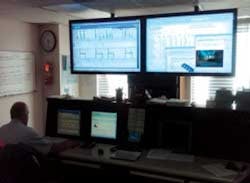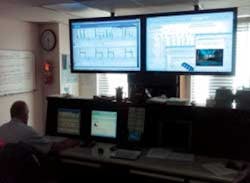System Provides De-Stratification, Aeration in Wastewater Lagoons
When recognizing the problems that municipal and industrial wastewater facilities face today with reduced budgets and increasing populations, lagoon aeration is an area where technology can convert to monetary savings.
The Reliant Water Technologies Model WQA was specifically designed to operate in shallow (5 feet to 12 feet deep) ponds and lagoons to provide aeration and de-stratification with a minimum of energy.
The Reliant Model WQA aeration and destratification system for shallow lagoons and ponds.
This patented water moving and aeration system requires only five feet of water to operate. It continuously moves all the water within a five acre pond or lagoon, and the weight of all that moving water will not only de-stratify the water body, but it can break up the bottom’s toxic dead zone, allowing for the ammonia and nitrogen components trapped there to rise and naturally dissipate through oxidation.
The Model WQA uses both coarse and fine bubble diffusion technologies. Using a total of only three horsepower of energy, it moves over 9 million gallons of water per day, and diffuses over 10 pounds of oxygen per hour into the water. The aeration component of the system can run continuously or periodically by manual or timer activation, or by automated dissolved oxygen monitors as required. The only maintenance requirement is the annual cleaning of two blower filters and the replacement of the filters every two to three years.
The system includes two regenerative blowers, each connected to a set of bubble forming diffuser grids. The 1 ½ hp Phase 1 blower runs 24 hours per day and feeds the rear-most diffuser grid which allows large, 1-2 cm. bubbles to rise quickly into a 45 degree baffle, pushing water across the surface of the pond. These large bubbles stay on the surface for up to 25 feet in front of the unit.
Once the surface water begins to move it will fall to the bottom, on a continual basis, bringing the bottom sediments, or sludge, into the water column where the nutrients will oxidize and aerobic organisms will thrive.
When the 1½ hp Phase 2 blower is initiated, either manually or automatically, it feeds air to a diffuser grid located forward of the base of the WQA. The bubbles emitted by those diffusers are smaller, approximately 1 mm in diameter. These small bubbles are kept underwater for up to 20 feet due to their inability to rise above the larger, faster and horizontally moving bubbles.
At only three total horsepower of energy, the Model WQA is extremely efficient when compared to other lagoon aeration technologies. How many units are needed in a wastewater lagoon is dependent on the required BOD load, but a good rule of thumb under normal conditions is to consider one unit per three to five acres of surface water.
The WQA system requires five feet of water to float and can be deployed in a lagoon up to 20 feet deep.
For more information on the system, visit the Reliant Water Technologies website at www.reliantwater.us.com.

